The History of Tea
Posted by OPEN DOOR TEA CT ADMIN

After water, tea is the most consumed beverage in the world. But while the drink is ubiquitous today, its history boils down to one accidental cup consumed nearly five millennia ago. Read on to discover the birthplace and history of tea.
TEA FOR ONE - THE FIRST CUP
Legend has it that in the year 2737 B.C., the Chinese emporer Shen Nung (or “Shennong”) is said to have been waiting beneath a tree for his servant to boil a cup of hot water for drinking when the wind blew some leaves into the water. The emperor – a renowned herbalist and thought by some to be the father of Chinese agriculture – decided to drink the infusion anyway, and the concept of tea was born. The myth implies that the leaves in the emperor’s water that fateful day blew in from the nearest camellia sinensis plant, and thus, Shen Nung became the world’s first tea drinker.
Camellia sinensis - a flowering evergreen shrub thought to be indigenous to China – is the plant from which all “true teas” come from today. All black, green, white, and oolong tea is made with this one plant, while herbal tisanes (colloquially called “herbal teas”) are made from other botanical sources, from herbs and flowers to berries and seeds.
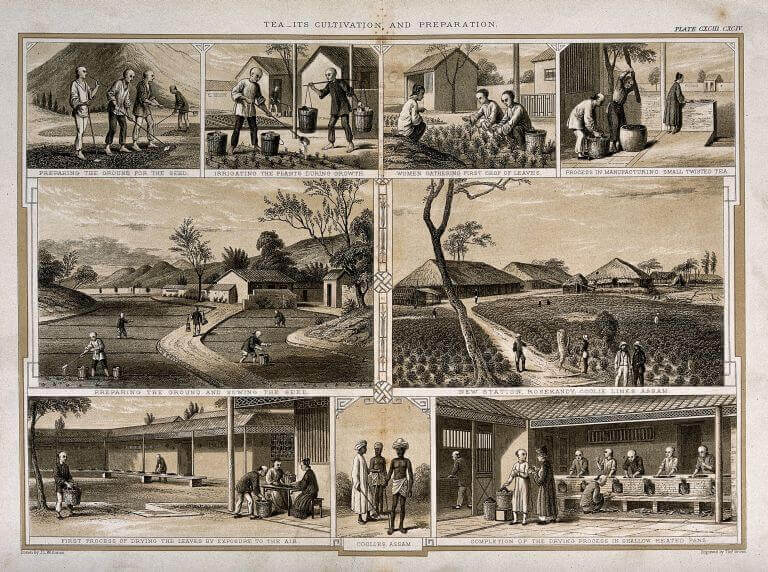 Tea cultivation and preparation
Tea cultivation and preparation
TEA IN CHINA - POPULARIZATION
Containers for tea have been found in Chinese tombs dating from the Han dynasty (206 BC – 220 BC) but it was under the Tang dynasty (618-906 AD) that tea became firmly established as the national drink of China.
Around 760 AD, a Chinese writer named Lu Yu composed what is believed to be the first written essay/study focusing on tea. The book, titled Ch’a Ching (roughly translated to mean “The Classic of Tea”), was divided into ten sections, each describing some aspect of tea’s horticultural details, historic relevance, instructions for preparation, drinking methods, and even a quick-reference guide to hang on the wall on a silk scroll.
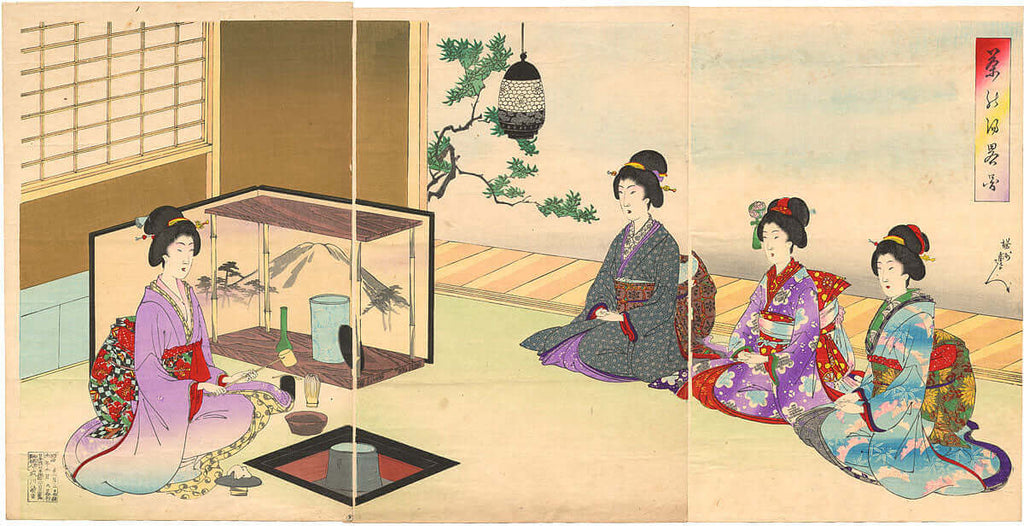 Japanese Tea Ceremony
Japanese Tea Ceremony
TEA IN JAPAN

By the end of the Tang dynasty’s three-century reign in 906 AD, the act of drinking tea had become a common pastime across China, where the leaves were steamed and packed into brick-like cakes for easy transport and trading. Near the turn of the 13th century, a Japanese priest named Myoan Eisai – presently considered the founder of Zen Buddhism – took a trip to China and, as the story goes, returned home with tea seeds which he soon planted in Japanese soil. Years later, he wrote his own book about tea and gave it to a samurai general as a gift, sparking local interest in the mysterious beverage. Tea quickly became a vital part of Japanese culture, seen in development of the Tea Ceremony.
Over the next many decades, samurai warriors would gather together to drink tea and discuss politics. The beverage was used for a variety of medicinal purposes as well, thought to balance the body and the mind while warding off illness. Tea ceremonies were banned by the Japanese government in the 14th century over paranoia about political discussions, but they later resumed, and ritualistic matcha ceremonies are commonplace to this day.
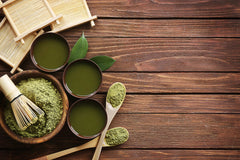 The most popular method of preparing tea involved grinding the delicate green tea leaves into a fine powder using a stone mill. This powder, called Matcha in Japan, was a precursor to the traditional Japanese tea ceremony ("Chanoyu"), popularized by the Zen monk Eisai. Matcha is prepared with bamboo whisks ("chasen") and served in hand-crafted bowls ("chawan").
The most popular method of preparing tea involved grinding the delicate green tea leaves into a fine powder using a stone mill. This powder, called Matcha in Japan, was a precursor to the traditional Japanese tea ceremony ("Chanoyu"), popularized by the Zen monk Eisai. Matcha is prepared with bamboo whisks ("chasen") and served in hand-crafted bowls ("chawan").
TEA FOR TWO - EUROPEAN EXPANSION
Tea was largely Asia’s secret until the 17th century, when it began making its way to Europe via Portugese and Dutch trade routes. A trading post was set up on the isle of Java by the Dutch in 1606 and the first transcontinental tea voyage took place between China and Europe. Tea soon became a fashionable drink among the Dutch, and from there spread to other nations in Western Europe. However because of its high price tag tea remained a drink for the wealthy.
Once tea made its way to England, it quickly became a luxury enjoyed almost exclusively by the elite class. It began with the court of Queen Catherine and Charles II: the queen, born in Portugal, loved tea and wished to drink it often, and the king cultivated a favorable relationship with the East India Company, a trade giant that operated with his full military support as it forcefully occupied lands of interest. The city of Mumbai (then known as Bombay) was given to Charles as part of Catherine’s dowry, and his decision to use its port as a trade hub played a large role in the influx of tea to Britain in the years that followed.
TEA FOR ALL
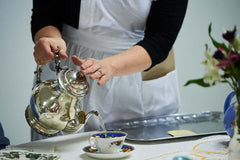 The first written record of tea in Britain can be found on a shopping list written in 1644 by a man in Leeds, requesting a bottle from his local apothecary. Its first public mention in the UK was a 1658 newspaper advertisement for a new drink from China being served at one of England’s first coffee houses, called “China Drink.” It was the marriage of Charles II to Catherine of Braganza that would prove to be a turning point in the history of tea in Britain. She was a Portuguese princess, and a tea addict, and it was her love of the drink that established tea as a fashionable beverage first at court, and then among the wealthy classes as a whole. Capitalising on this, the East India Company began to import tea into Britain, its first order being placed in 1664 - for 100lbs of China tea to be shipped from Java.
The first written record of tea in Britain can be found on a shopping list written in 1644 by a man in Leeds, requesting a bottle from his local apothecary. Its first public mention in the UK was a 1658 newspaper advertisement for a new drink from China being served at one of England’s first coffee houses, called “China Drink.” It was the marriage of Charles II to Catherine of Braganza that would prove to be a turning point in the history of tea in Britain. She was a Portuguese princess, and a tea addict, and it was her love of the drink that established tea as a fashionable beverage first at court, and then among the wealthy classes as a whole. Capitalising on this, the East India Company began to import tea into Britain, its first order being placed in 1664 - for 100lbs of China tea to be shipped from Java.
Throughout the remainder of the 17th century, men from the upper and middle classes would sip tea at coffee houses while women would drink it at home. But then, steep punitive taxation put such a chokehold on the price of tea toward the beginning of the 18th century that its sales almost ceased completely. The first tax on tea in the leaf, introduced in 1689, was so high at 25p in the pound that it almost stopped sales. It was reduced to 5p in the pound in 1692, and from then until as recently as 1964, when tea duties were finally abolished, politicians were forever tinkering with the exact rate and method of the taxation of tea.
With tax rates soaring wildly up to 100 percent or more, the cost of tea was doubling, and yet British thirst for the delicious drink was every bit as high. As a result, organized crime began to rise, with gangs smuggling millions of pounds of tea to the masses, stuffing the bricks with filler along the way to inflate their profits. Their methods could be brutal, but they were supported by the millions of British tea drinkers who would not have otherwise been able to afford their favorite beverage. What began as a small time illegal trade, selling a few pounds of tea to personal contacts, developed by the late eighteenth century into an astonishing organized crime network, perhaps importing as much as 7 million lbs annually, compared to a legal import of 5 million lbs! Worse for the drinkers was that taxation also encouraged the adulteration of tea, particularly of smuggled tea which was not quality controlled through customs and excise. Leaves from other plants, or leaves which had already been brewed and then dried, were added to tea leaves. Sometimes the resulting color was not convincing enough, so anything from sheep's dung to poisonous copper carbonate was added to make it look more like tea.
Stateside, notable smugglers included John Hancock and Samuel Adams, and in 1765, the Sons of Liberty famously organized the Boston Tea Party, during which they dressed as Native Americans and dumped more than 300 chests full of tea overboard into Boston Harbor as a form of protest against taxation without representation.
By 1784, the government realised that enough was enough, and that heavy taxation was creating more problems than it was worth. The new Prime Minister, William Pitt the Younger, slashed the tax from 119 per cent to 12.5 per cent. Suddenly legal tea was affordable, and smuggling stopped virtually overnight.
 Boston Tea Party dumping tea in the harbor.
Boston Tea Party dumping tea in the harbor.
TEA & TEMPERANCE
As tea became the drink of the people, debates began to arise over its health benefits or lack thereof. Members of the wealthy class wondered if excessive tea consumption might bring about a sense of sluggishness among the working class, and without the benefit of today’s clinical knowledge, they were clueless about the health benefits associated with the ancient drink in all its many forms
A curious footnote in the history of tea is its role in the temperance movement of the early 19th century. Concerns about tea’s effects on the body and mind began to take a backseat to the drink’s role as a substitute for alcohol, and British philanthropists started offering it at temperance meetings, encouraging attendees to lay off the liquor and drink tea instead. Largely a movement of the working class in an attempt to gain the respect of those more powerful, the temperance movement gave birth to the term “teetotaling,” which meant abstaining from alcohol consumption. The word’s relationship to tea is tenuous at best, but many teetotalers drank tea instead of spirits for extended periods of time.

TEA TRADING & CONSUMPTION
Another great impetus to tea drinking resulted from the end of the East India Company's monopoly on trade with China, in 1834. Before that date, China was the country of origin of the vast majority of the tea imported to Britain, but the end of its monopoly stimulated the East India Company to consider growing tea in India. India had always been the centre of the Company's operations, where it also played a leading role in the government. This led to the increased cultivation of tea in India, beginning in Assam. There were a few false starts, including the destruction by cattle of one of the earliest tea nurseries, but by 1839 there was sufficient cultivation of tea of 'marketable quality' for the first auction of Assam tea in Britain. In 1858 the British government took over direct control of India from the East India Company, but the new administration was equally keen to promote the tea industry and cultivation increased and spread to regions beyond Assam. It was a great success, production was expanded, and by 1888 British tea imports from India were for the first time greater than those from China.
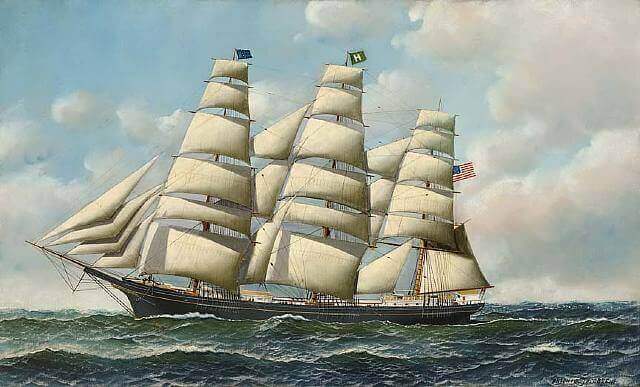 American Tea Clipper
American Tea Clipper
TEA CLIPPERS
The end of the East India Company's monopoly on trade with China also had another result, which was more dramatic though less important in the long term: it ushered in the era of the tea clippers. While the Company had had the monopoly on trade, there was no rush to bring the tea from China to Britain, but after 1834 the The tea clipper Thermopylaetea trade became a virtual free for all. Individual merchants and sea captains with their own ships raced to bring home the tea and make the most money, using fast new clippers which had sleek lines, tall masts and huge sails. In particular there was competition between British and American merchants, leading to the famous clipper races of the 1860s. The race began in China where the clippers would leave the Canton River, race down the China Sea, across the Indian Ocean, around the Cape of Good Hope, up the Atlantic, past the Azores and into the English Channel. The clippers would then be towed up the River Thames by tugs and the race would be won by the first ship to hurl ashore its cargo at the docks. But these races soon came to an end with the opening of the Suez canal, which made the trade routes to China viable for steamships for the first time.
In 1851, when virtually all tea in Britain had come from China, annual consumption per head was less than 2lbs. Bt 1901, fuelled by cheaper imports from India and Sri Lanka (then called Ceylon), another British colony, this had rocketed to over 6lbs per head. Tea had become firmly established as part of the British way of life. This was officially recognised during the First World War, when the government took over the importation of tea to Britain in order to ensure that this essential morale-boosting beverage continued to be available at an affordable price. The government took control again during the Second World War, and tea was rationed from 1940 until 1952. 1952 also saw the re-establishment of the London Tea Auction, a regular auction that had been taking place since 1706. The auction was at the centre of the world's tea industry, but improved worldwide communications and the growth of auctions in tea producing nations meant that it gradually declined in importance during the latter half of the twentieth century. The final London Tea Auction was held on 29 June 1998.
ICE TEA & TEA BAGS
 Iced tea originated at the 1904 World's Fair in St. Louis, Missouri. A tea merchant from abroad had intended to provide visitors with free hot tea samples. However, due to the unusually hot weather, it was not a big hit. To promote sales, he asked a nearby ice cream vendor for some ice, which he dumped into the brewed tea. Thus, the American iced tea tradition was born. Today, iced tea makes up around 80% of the entire U.S. tea market sales.
Iced tea originated at the 1904 World's Fair in St. Louis, Missouri. A tea merchant from abroad had intended to provide visitors with free hot tea samples. However, due to the unusually hot weather, it was not a big hit. To promote sales, he asked a nearby ice cream vendor for some ice, which he dumped into the brewed tea. Thus, the American iced tea tradition was born. Today, iced tea makes up around 80% of the entire U.S. tea market sales.
The original tea bags were handmade, hand stitched muslin or silk bags. Patents for tea bags existed as early as 1903. However, Thomas Sullivan, a tea merchant from New York, is often credited with creating the first commercial tea bag concept.
TEA TODAY
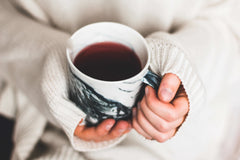
Advances in 20th and 21st century medical research have brought about a deeper understanding of tea’s benefits for the body and mind, and new findings are published on a regular basis. From the anti-inflammatory, anti-microbial and antioxidant properties of teas and tisanes to the ways this ancient drink can play a role in treating specific issues, we learn new and exciting things each day about how good tea can be for us. With regard to our immune systems, the emerging field of integrative medicine combines modern treatments with natural remedies, and as we continue to learn with each new study, a daily cup or two of tea can be just what the doctor ordered.
From classic pots of English Breakfast and traditional bowls of matcha to strong oolong blends and gentle tisanes, the right cup of tea can empower us during the day, gently relax us, or even help to cure our ailments. Once an accidental beverage brewed by a breeze, tea is now a universal tonic that soothes the soul and heals the body in ways we’re just beginning to fully realize. It all began with just one cup.
TAGS:


